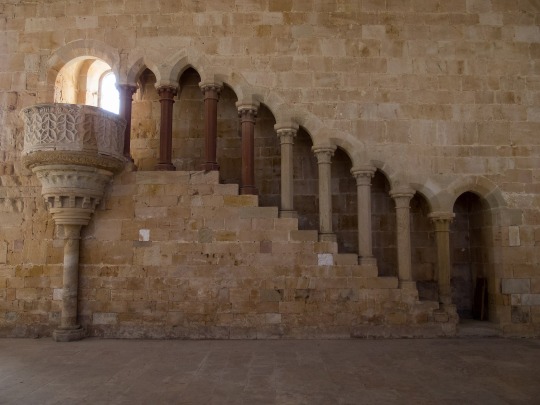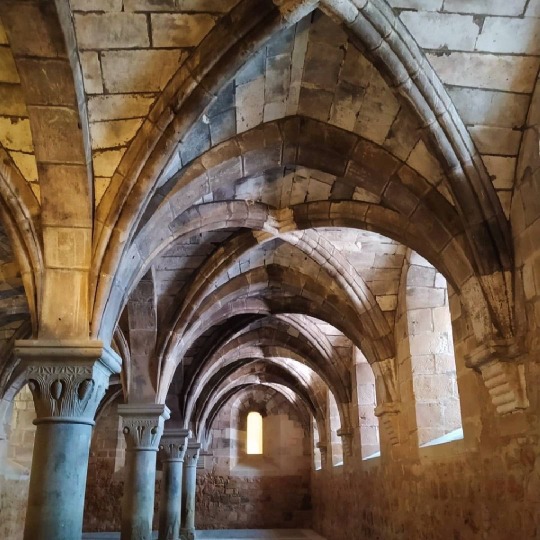#cistercian monastery
Explore tagged Tumblr posts
Text

Full-body relic of Saint Hyacinth in the former cistercian monastery Fürstenfeld abbey, Germany.
#bizarre au havre#relic#saint#saint hyacinth#monastery#cistercian monastery#fürstenfeld abbey#germany#dark#photography#skeleton
29 notes
·
View notes
Video
Openings and Conclusions 6 by Russell Moreton Via Flickr: Collage on paper, written fragments and images from Peter Greenaway, Josef Albers and Robin Evans. Photo montage of The Physical Self (Greenaway) and Waverley Abbey UK. Visual research as part of The Waverley Project/Obscura and Reading Room. On the horizon, then, at the furthest edge of the possible, it is a matter of producing the space of the human species-the collective (generic) work of the species-on the model of what used to be called "art" ; indeed, it is still so called, but art no longer has any meaning at the level of an "object" isolated by and for the individual. Henri Lefebvre, Openings and Conclusions. from On Installation and Site Specificity (introduction) Erika Suderburg
#Research Collage#Working Notes#Interior Documents#Visualisations#Architectures#Spaces#Place#Embodiments#Practices#Texts#Material#Mappings#Drawings#Site#Localities#Mark Dion#Peter Greenaway#Herzog and de Meuron#Henri Lefebvre#Robin Evans#Kate Whiteford#Colin Renfrew#Remote Sensing#Archaeology#Rodin#Beuys#The Sensitivities of the Physical Self#Josef Albers#Waverley Abbey#Cistercian Monastery
3 notes
·
View notes
Text

Villa Monastero, Varenna,Italy
The villa, which began as a Cistercian Monastery in the 12th century, later became a private home. The last owners donated it and today it is a public museum and botanical garden.
The garden, which has evolved over more than a century, meanders for about a mile along the lake. The plants, many quite unusual, have come from all over the world. There are evergreen trees, giant cacti, palms, citrus trees, vines and flowers. The combination of colors, sizes, forms and textures creates a truly special garden.
The garden is more than just plants. It’s an architectural and artistic wonder as well. The setting includes terraces, fountains, sculptures, ornately carved balustrades, ironwork, and breathtaking views.
More on:https://www.twopartsitaly.com/blog/category/Lake+Como
#villa Monastero#Varenna#Lake Como#Italy#Cistercian Monastery#12th century#museum#architecture#gardens#sculptures#aesthetic#old
6 notes
·
View notes
Text

Monastery of Saint Mary of Iranzu, Navarre, Spain,
It was founded in the late 12th century. The cloister is partly Cistercian (12th century) and partly Gothic (13-14th centuries).
#art#design#doorway#architecture#heavensdoorways#entrance door#arches#architraves#monastery#spain#navarre#12th century#gothic#cistercian
22 notes
·
View notes
Text

'Beauty for ashes' - the ruins of Melrose Abbey in southern Scotland
#Melrose Abbey#Roxboroughshire#Scottish Borders#churches#monastery#Cistercian#mediaeval#Christendom#AD 1126#Gothic architecture#perpendicular#flying buttresses#ruins
100 notes
·
View notes
Note
honestly thank you for pointing out that whole "their robes are that color because they're too poor to dye them black" because i would have probably not picked that up just by reading the book once. i was going a little crazy trying to figure out their order from the game alone so when i first started the book i was pretty surprised that they were so clearly benedictine.
do you think they had a reason for not leaning into that in the game? i figured it would've not been hard to put that in some of the dialogue but idk
sorry I don't get the question, are you asking why they didn't learn into being Benedictine in the game? as much as it's a format restraint, I think it's also an 'accessibility' thing, being more palatable to get into and not being too heavy on like. Actual Information
#trying to thinm of other orders they can be and hmmb... i don't think they can be anything wlse#sorry im answering this after just having woken up but. franciscans werent real yet and cistercians weren't in england yet i think..#and the first carthusian monastery wasnt founded until thomas becketts murder. which is at the last part of the book#they never did once allude to what order they are you're right.. i wish they did get into the details of things#any detail they had was put in the inventory section for reading. sighs sadly#birbwellspeaks#pillars of the earth#the pillars of the earth
7 notes
·
View notes
Text







Tintern Abbey, Co. Wexford, December 2024
5 notes
·
View notes
Text

Former Cistercian monastery, the Château de la Ferté in Saint-Ambreuil, Burgundy region of France
French vintage postcard
#the château de la ferté#vintage#photography#saint#postkarte#fert#french#carte postale#de#postal#region#briefkaart#france#postcard#old#cistercian#burgundy#historic#monastery#photo#ansichtskarte#sepia#chteau#ambreuil#postkaart#ephemera#la#tarjeta#saint-ambreuil
9 notes
·
View notes
Link
Why were and are there so many different types of monks? What’s the difference between Benedictines, Cistercians, Carthusians, Norbertines, Augustinians, and other monks? Why were monks “Spiritual Warriors”? Discover here why there were so many different types of monks in the Middle Ages and the main medieval orders, and also the chief differences between these different monastic orders, at least in the Middle Ages.
#Monks#Medieval#Middle Ages#Benedictine#Cistercian#Carthusian#Norbertine#Premonstratensian#Augustinian#Austin Canon#Spiritual Warriors#Monastery#Abbey
1 note
·
View note
Text
Like so many northern abbeys, Byland was destroyed by border wars.

It's easy to see why Byland Abbey was once one of the greatest monasteries in England.
that this abbey inspired the design of church buildings throughout the North, including the famous York Minster rose window
#Byland Abbey#Ryedale#North Yorkshire#monastery#UK#church ruins#Cistercian#12th century#Helmsley#border wars#Gothic architecture#monastic order#sacred space#mediaeval
46 notes
·
View notes
Text

Coat of arms of Ebersbach monastery on a 400 year old bookcase
This is a "talking" coat of arms, which depicts the name of the monastery. Eber is a male wild boar, bach means creek. Accordingly, the coat of arms shows a monastery, a wild boar, and a creek.
According to the legend, monks frim Burgundy were sent out to found a new monastery at the right bank of the river Rhine in the early 1100s. Since the rule of the Cistercian order called for a reclusive place far away from civilization with access to fresh water. They found good conditions at a side valley of the river Rhine opposite of the ancient city of Mainz, but were undecided about the exact spot. Suddenly, a wild boar came out of the forest and jumped over the creek three times. And because three is a holy number, the monks took it as a signnof God to found the monastery at this very spot and named it Ebersbach – boar creek.
This old bookcase caused major trouble when a conference of the NATO defense ministers was to be held in the dining room of the monastery where the bookcase stands. One of the delegations feared that a bomb may have been placed in the bookcase and demanded it to be opened and inspected. However, the key is lost since centuries and the bookcase has never been seen open. The organizers of the meeting had a very hard time to convince the delegation that the old bookcase posed no danger, but managed eventually to do so, and the conference took place as scheduled.
39 notes
·
View notes
Text

Inktober day 29: Idia & Ortho Shroud // La mà fidel de l'amic
La mà fidel de l'amic (The hand of the loyal friend) is the myth about how la Santa Mà (the Holy Hand), kept in the monastery of Vallbona de les Monges (L'Urgell) came to be.
It says that in the cistercian monastery of Santes Creus (Alt Camp) lived two inseparable monks. They did everything together and only separated when going to sleep, although their cells were next to each other.
As years passed and they got older, they started to talk more frequently about death and how much they feared that when one of them died the other would be left all alone, only taking comfort of their eventual reunion in the afterlife. But sometimes, they started to doubt the existence of the afterlife and that scared them even more, not because they would cease to exist but because they wouldn't be together anymore.
So one day one monk proposed to the other "when one of us dies, he would send a signal if there's an afterlife and if there is no signal, then there's nothing after death.".The other monk gladly accepted.
When one of them eventually died, the other monk was already waiting for his friend's signal, but it didn't come, not that night during the vigil, not the next day during the burial, nor the next, or the next,...
But the still alive monk didn't lose hope, he visited his friend's grave everyday and wait for the signal, but the signal never came. Years passed, but no signal.
But one day when the monk was but a wrinkled old man, while he was praying in front of his friend grave, he heard a creak. Looking around he saw a crack in the tombstone and from there a dried up bony hand appeared. The monk was overjoyed! His friend sent the signal! They would be together once again!
Elated the monk explained what had happened to the abbot and the rest of the monastery. Surprised the abbot decided that they'll come next day and see for themselves. And see they did, the hand once again came out of the tombstone.
They read some prayers and once they were finished, the hand extended some more and when the abbot when to shake the hand, it broke of. They carried back to the manastery, where they revered it as another relic. Nowadays the relic is kept in Vallbona de les Monges.
#twisted wonderland#twst#idia shroud#ortho shroud#inktober#inktober 2024#my art#it was them or Rollo and his also very dead little brother
26 notes
·
View notes
Video
Openings and Conclusions 9 by Russell Moreton Via Flickr: On the horizon, then, at the furthest edge of the possible, it is a matter of producing the space of the human species-the collective (generic) work of the species-on the model of what used to be called "art" ; indeed, it is still so called, but art no longer has any meaning at the level of an "object" isolated by and for the individual. Henri Lefebvre, Openings and Conclusions. from On Installation and Site Specificity (introduction) Erika Suderburg
#Research Collage#Working Notes#Interior Documents#Visualisations#Architectures#Spaces#Place#Embodiments#Practices#Texts#Material#Mappings#Drawings#Site#Localities#Mark Dion#Peter Greenaway#Herzog and de Meuron#Henri Lefebvre#Robin Evans#Kate Whiteford#Colin Renfrew#Remote Sensing#Archaeology#Rodin#Beuys#The Sensitivities of the Physical Self#Josef Albers#Waverley Abbey#Cistercian Monastery
2 notes
·
View notes
Note
"Hore Abbey is a ruined Cistercian monastery near the Rock of Cashel, County Tipperary, Republic of Ireland." Is that where you're from?
I'm going to dash you against the rocks like an hawk with a turtle
32 notes
·
View notes
Text



Monastery of Santa María la Real de Huerta, a Cistercian monastery located in the town of Santa María de Huerta, Soria (Spain). Built between the 12th and 16th centuries.
The refectory (monastic dining room) is the jewel of the monastery
496 notes
·
View notes
Text

Happy Feast Day
Saint Anthony Mary Claret
1807-1870
Feast day: October 24 (New), October 23 (Trad)
Patronage: Claretians (Missionary Sons of the Immaculate Heart of Mary), Technical and Vocational Educators, Weavers, Textile Merchants, the Diocese of the Canary Islands
Saint Anthony Mary Claret was drawn to the religious life as a child and became a secular priest. He was a missionary, social reformer, Queen Isabella’s chaplain, a writer, and publisher, established schools and libraries and was a refugee. In 1850, he was appointed Archbishop of Cuba where he made many social reforms. Because of it, assassins tried to kill him 15 times. He established the Claretians to spread his dream of missionary and reform work. In 1869 The First Vatican Council meeting, where he forcefully defended papal infallibility. He died close to his birthplace in a Cistercian monastery.
Prints, plaques & holy cards available for purchase. (website)
#St Anthony Mary Claret#Claretians#Canart Island saint#catholic art#catholic faith#portraitsofsaints
29 notes
·
View notes
